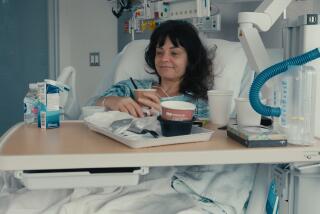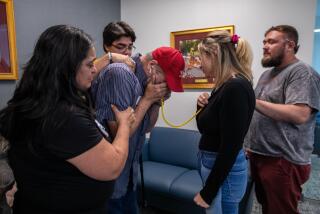Living Organ Donors Often Oblivious to Risks They Run
WASHINGTON â The transplant was drawing near, and Kimberly Tracy knew that she might die. She sat down to write her 2-year-old nephew a letter.
âIâm writing this letter to you now in case I canât tell you later,â Tracy typed on her computer as she prepared to give him one of her kidneys. âMaybe something went wrong during the transplant or I became ill afterwards.... All I know is that I wanted to tell you how much I love you.â
She slipped the pages inside the folder with her will and life insurance documents. Soon after, her healthy kidney was transplanted into her nephewâs tiny, sick body.
Tracy, 45, a nurse from Dayton, Ohio, survived, as did her nephew. But it was hardly the no-big-deal operation that her doctors had promised. For months afterward, Tracy would vomit for no clear reason. She had abdominal cramps and shooting pelvic pain.
Yet complications like Tracyâs are seldom reported or talked about, even as the number of living donors is skyrocketing. Increasingly, patients desperate for transplants are turning to families, friends, even acquaintances or co-workers for vitally needed organs.
Living donors now outnumber the traditional source of organs -- cadavers -- with 6,613 living donors last year, more than triple the number in 1990, according to the United Network for Organ Sharing, which runs the nationâs transplant system.
Few living donors die, and there are no reliable statistics about their surgical complications. But existing data suggest that as many as one in three liver donors, for example, face such complications as more surgery, hospitalization and extended recovery periods.
Transplant programs donât always provide donors with detailed information about the risks. And thereâs no central place where donors can go for unbiased information -- not just about obvious side effects, but about time lost from work, pain, discomfort and expenses.
Moreover, the organ donation system has its own built-in contradictions. A physicianâs guiding principle instructs to do no harm, yet living donation removes an organ from a healthy person who will derive no medical benefit from the procedure.
Most donors have no regrets; many have only minimal pain.
âI used the morphine pump for the first day. Then I didnât need it anymore,â said Ellen Souviney, 48, of Brunswick, Maine, who gave a kidney to her personal trainer. âI didnât even need aspirin after that.â
Others are less satisfied. Tracy has begun an informal support network for living donors and is creating a Web site to help educate potential donors. She, too, has no regrets, but says: âMy main concern is living organ donations will soon get a bad name if things arenât changed in the medical system.â
Many in the field, including a federal advisory panel, are calling for fundamental change. Two ideas have emerged: a national registry to keep track of donors and their conditions after a transplant, and independent donor advocates at every transplant hospital who can dispassionately explain the risks.
The rise in living donations makes change all the more crucial, said Gregory Pence, a bioethicist at the University of Alabama. He and others worry that living donation has become so common that family and friends feel intense pressure to donate if they are a medical match.
âYou really have to ask, âDo people know what theyâre getting in for?â â he said. âNo one really knows.â
Moreover, each hospital has its own criteria for approving donors, with no standard guidelines.
In 1999, four Canadian hospitals refused to let a housekeeper donate a kidney to her ill boss, a wealthy Toronto developer, because of concerns that anyone donating to an employer might be under pressure to do so. But the developer turned to the Mayo Clinic in Rochester, Minn., which concluded that the housekeeper was acting out of compassion and performed the surgery.
Donor deaths are rare, although sometimes well publicized -- such as the reporter who died in New York in 2002 after giving a part of his liver to his brother. His death prompted a New York advisory committee to recommend what would be the strictest guidelines in the country for living donations, including a state registry of donors and restrictions on who can donate.
Nationally, the transplant network has identified 28 donor deaths to date, including five that were definitively linked to the donation. And as of 2002, 56 kidney donors later needed a kidney transplant themselves.
As for less-than-fatal complications, the data are thin. The National Institutes of Health is set to begin a study of liver donors later this year. A limited registry of kidney donors has enrolled about 250 people so far, but the results have not been published or shared with any donors or doctors.
Researchers at a transplant conference last month estimated that nearly one in three liver donors suffers a medical complication. About half are serious, perhaps requiring a second surgery; others are relatively minor, such as wound infections. One study found that 30% of donors had to be readmitted to the hospital.
They found the typical living donor is hospitalized for about 10 days, takes 2 1/2 months off work and needs another month for complete recovery.
Although many donors say the experience was the best of their lives, some complain that they werenât adequately prepared.
Walter Woodâs abdominal muscles ruptured after he gave his brother a kidney. He lost his job because he could no longer lift heavy boxes. He had to sell his house and came close to bankruptcy.
âIâm in constant pain from the surgeries Iâve had. I canât even move around in bed,â said Wood, 45, who now lives in Myrtle Beach, S.C.
Arielle Dove decided to donate a kidney to someone in need after the Sept. 11 terrorist attacks, and found a match through a living donor message board on the Internet. Today, sheâs sick -- regularly vomiting, lethargic and dizzy. Sheâs also angry: The man who got her kidney reneged on a promise to cover her expenses that were not paid for by his insurance.
âI volunteered to put my life on the line, and I guess Iâve given up my good health for this and nobody seems to care,â she said. âItâs really hard not to cry.â
And Michelle Glasgow in Billings, Mont. -- herself a doctor -- had horrible pain in her side after donating a kidney to her brother. She lost 45 pounds over five months.
âIt was just too painful to eat,â she said.
âIn the beginning, they love you. They need you to do the transplant,â she said of her transplant doctors. âAfterwards, their attitude towards you is, âWeâre done with you. Move on. We have more people.â â
Transplant surgeonsâ reactions vary widely. Dr. Thomas Bak, a Denver surgeon who cared for Glasgow, said he had no idea that she felt so negative about her experience.
âYou feel directly responsible for the follow-up care,â Bak said. âAt the same time, if that person breaks their ankle or gets a cold, Iâm not their physician for the rest of their life.â
Transplant programs have some inherent conflicts of interest in dealing with potential living donors.
Certainly, doctors are trying to save the life of a sick patient. Less charitably, the transplant program and its doctors make money and gain prestige with every transplant performed.
âWhat theyâre thinking about is, âI need to get these organs.â They donât have the donorâs interest central,â said Arthur Caplan, a bioethicist at the University of Pennsylvania.
Some in the transplant community agree. âThe transplant center has goals of doing more transplants,â said Dr. Francis L. Delmonico, chief of transplant services at Massachusetts General Hospital.
Some centers try to minimize the conflict by assigning separate surgeons to the donor and the recipient.
There can also be conflicts between recipient and donor. For instance, should a potential donor be told that the recipient has hepatitis C, which can return and infect the new organ?
Hoping to address some of these issues, a federal organ transplantation advisory council recommended hiring donor advocates to work independently with potential donors. But many surgeons donât want an outsider involved.
âI donât think they would put more emphasis on the risks than I do,â said Bak, the Denver kidney surgeon. âI give them absolute truths about everything that can happen, from major to minor.â
But Dr. Elizabeth A. Pomfret, who directs the live donor liver program at the Lahey Clinic in Burlington, Mass., says her program employs a doctor and a psychologist who are independent -- and either can veto transplants. She said itâs partly to eliminate surgeonsâ conflicts of interest, and partly to make it easier for the potential donor to disclose apprehension or pressure from family when they arenât sure they want to donate.
âThere has to be somewhere for that to be vented without them feeling like theyâre not being a good brother or sister or daughter to the surgeon whoâs been taking care of their loved one,â she said.
For all the worries, most say they would do it again, knowing that they have saved a life.
âThere are times I feel sorry for myself,â Walter Wood said. Then he thinks of his brother. âHis three kids have their dad still. I try to keep that in front of me too.â
*
(BEGIN TEXT OF INFOBOX)
Proposals to Safeguard Living Organ Donors
Several organizations have made recommendations aimed at protecting living donors.
The United Network for Organ Sharing, which runs the nationâs transplant network under a government contract, agreed at its June meeting that:
* Hospitals that want to perform living donor transplants should meet minimum criteria, such as having surgeons with significant experience. Other hospitals may still perform the transplants, but lack of UNOSâ approval could be a red flag to patients and / or insurance companies.
* The questionnaire used to track the well-being of living donors will be updated. But many donors are never interviewed, and the networkâs action will not change that.
* Potential living donors âshould have a psychosocial evaluation.â The network rejected a proposal to make this mandatory.
* The network will develop educational materials for potential living donors explaining the risks and the donation process.
The New York State Transplant Council Committee on Quality Improvement issued a series of recommendations, now under review by the state Health Department, after a 35-year-old donor died in 2002:
* Hospitals performing living donor transplants would be required to have donor advocate teams with power to veto any donor candidates. Hospital transplant programs would have to have minimum staffing ratios and experienced surgeons.
* Only patients age 55 and under, who have suffered at least one complication from their disease, would be eligible to get livers from living donors.
* The state would create a donor registry; reporting of donorsâ short- and long-term outcomes would be mandatory.
* Hospitals could only take organs from people who have a âvital emotional relationshipâ to the recipient, thus nixing âgood Samaritanâ donations from strangers.
The federal Advisory Committee on Transplantation made several recommendations to the secretary of the Department of Health and Human Services, and they have been forwarded to UNOS or other agencies for consideration:
* The government should create a standardized informed consent document to make sure that all potential donors understand the risks.
* All hospitals must have independent donor advocates.
* The department should establish a database of health outcomes of all live donors.
* An independent resource center should be considered to assist living donors and their families.
* The organ allocation system should be changed to give all living donors preference should they someday need an organ transplant. Current policy only gives preference to kidney donors who later need a kidney.
* Hospitals that take organs from living donors should have to meet certain standards.
Source: Associated Press
Los Angeles Times






